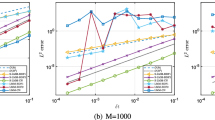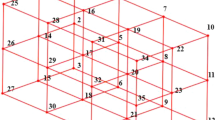Abstract
In the paper a generalised model is proposed which encompasses a number of known models of the mechanical material behaviour: the normal stress hypothesis, the maximum strain hypothesis, rotationally symmetric potentials (v. MISES, BELTRAMI, cone, paraboloid- and hyperboloid potentials) and the model of SAYIR. The model gives rise to some new solutions which extend the classic hypotheses. The model is build up of the three invariants of the stress tensor and has five free parameters. Parameters are restricted to yield a convex form. Some convex forms of the model, which contains the stresses to the power three or two, are constructed in the paper.
Zusammenfassung
In dieser Arbeit wurde ein kubisches Modell des Materialverhaltens entwickelt, das mehrere bewährte Hypothesen beinhaltet: die Normalspannungshypothese, die Größtdehnungshypothese, rotationssymmetrische Modelle (v. MISES, BELTRAMI, Konus-, Paraboloid- und Hyperboloidpotenzial) und auch das Modell von Sayir. Aus dem vorgeschlagenen Modell ergeben sich mehrere neue Hypothesen, die die klassischen Hypothesen erweitern. Das Model ist eine Funktion von drei Spannungsinvarianten und beinhaltet fünf Parameter. Diese Parameter sind durch die Konvexitätbedingung begrenzt. Einige konvexe Formen des Modells, die die Spannung in der Potenz drei oder zwei beinhalten, werden in dieser Arbeit diskutiert.
Similar content being viewed by others
References
Altenbach H, Altenbach J, Zolochevsky A (1995) Erweiterte Deformationsmodelle und Versagenskriterien der Werkstoffmechanik. Deutscher Verlag für Grundstoffindustrie, Stuttgart
Betten J (2002) Creep mechanics. Springer Verlag, Berlin
Backhaus G (1983) Deformationsgesetze. Akademie Verlag, Berlin, pp 238–246
Źyczkowski M (1981) Combined loadings in the theory of plasticity. PWN-Polish Scientific Publ.
Kolupaev VA (2006) Dreidimensionales Kriechverhalten von Bauteilen aus unverstärkten Thermoplasten. Diss., Martin-Luther Universität Halle-Wittenberg, Papierflieger Verlag, Clausthal- Zellerfeld
Bardenheier R (1982) Mechanisches Versagen von Polymerwerkstoffen: Anstrengungsbewertung mehrachsialer Spannungszustände. Carl Hanser Verlag, München
Ismar H, Mahrenholtz O (1982) Über Beanspruchungshypothesen für metallische Werkstoffe. Konstruktion 34:305–310
Sayir M (1970) Zur Fließbedingung der Plastizitätstheorie. Ing Arch 39:414–432
Kolupaev VA, Moneke M, Rudschuck M, Becker B (2005) Modellierung des mehraxialen Grenzverhaltens von Keramiken. Symposium Hochleistungskeramik, 12–13 Oktober 2005, Selb, pp 150–153
Kolupaev VA, Kraatz A, Moneke M, Bolchoun A (2006) Beschreibung der mehraxialen Kriechphänomene bei Hartschaumstoffen. KGK – Kaut Gummi Kunstst 59(1–2):17–27
Author information
Authors and Affiliations
Corresponding author
Rights and permissions
About this article
Cite this article
Kolupaev, V.A., Bolchoun, A. & Moneke, M. Convex forms of the cubic model . Forsch Ingenieurwes 71, 21–27 (2007). https://doi.org/10.1007/s10010-006-0041-5
Received:
Published:
Issue Date:
DOI: https://doi.org/10.1007/s10010-006-0041-5




